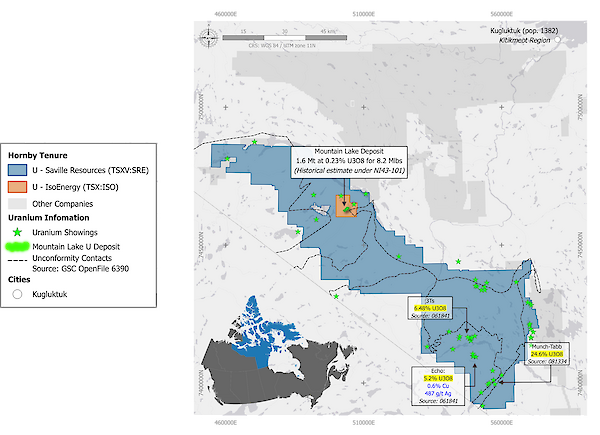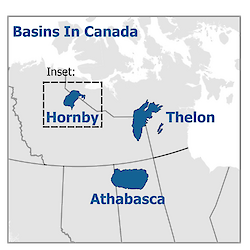Future Fuels’ Hornby project covers the entire Hornby Basin in north-western Nunavut. The company consolidate the district through a series of acquisitions and claim staking leading to a significant land package totalling 3407 km2. The Hornby Basin was formed contemporaneously with the world class Athabasca Basin and shares many similar geological characteristics. The Basin hosts the Mountain Lake Deposit that was discovered in 1976 and the basin has never been held in its entirety by a single operator since. Future Fuels identified this as the last under-explored uranium bearing basin in Canada and believes employing a systematic, basin wide, exploration strategy, the Hornby Basin has potential to host multiple uranium deposits.

Future Fuels’ Hornby Project, showing locations claim package and historically high-grade sampling
Location
The project is located in the uriniferous area known as the Hornby Basin, in Canada’s territory of Nunavut. Only 95 km SW of Port town of Kugluktuk, 145 km NNE of Port Radium, 555 km NNW of Yellowknife. The extensive consolidated land package totals 3407km2 and contains over 40 underexplored uranium showings outside of the Mountain Lake Deposit. The project can be accessed by float and tundra plane, and helicopter. The summer field season extends from April to October allowing for boots on the ground exploration, and the winter field season allows for drilling and airborne geophysics.
Historic Work
Most of the basin has seen some exploration, but the cyclical nature of the Uranium sector prevented further discoveries from being made post-Mountain Lake, further imeded by the compartmentalised nature of the basins ownership. The first phase of serious exploration occurred between 1977 to 1988 following the mountain lake discovery. BP Minerals, Cominco, Gulf Minerals Canada, Imperial Oil spent over $10m during this period.
The last concerted effort of exploration occurred between 2005 to 2011 where Cameco, Unor, Triex and Adriana reported to spend over $20m extensive regional geophysical surveys, and drill testing of some targets. When the market turned in 2011, the majority of anomalies were left with no follow up presenting a prime opportunity for SRE to pick up where the majors left off.
The Basin
In Canada, there are three large Helikan-aged uriniferous basins, the Athabasca, the Thelon and the Hornby basins.
 Athabasca’s Uranium potential was identified in the early 1950s . During the course of 1970-2020 more than 500mlbs of uranium has been produced from this prolific region with over 40 uranium deposits being discovered, defining 2.6 billion pounds of uranium.
Athabasca’s Uranium potential was identified in the early 1950s . During the course of 1970-2020 more than 500mlbs of uranium has been produced from this prolific region with over 40 uranium deposits being discovered, defining 2.6 billion pounds of uranium.
In the Thelon Basin, Urangesellschaft Canada Limited discovered the first uranium showing in the Baker Lake area of the Thelon Basin in 1974.
A secondary rush in the 2000s to 2011 saw regional work hunting for unconformity-type uranium and to date around 160 million pounds of Uranium has been defined.
The Opportunity
With over 40 already defined targets to follow up, access to a significant dataset acquired by major uranium companies, FTUR is positioned well to launch into a new phase of exploration in the Hornby Basin. New geophysical techniques, a friendlier exploration and development jurisdiction, and improved exploration infrastructure in the region will enable Future Fuel to deploy resources more effectively than previous operators and significantly increase the chances of further discoveries.
